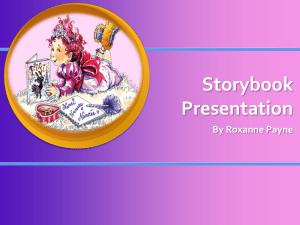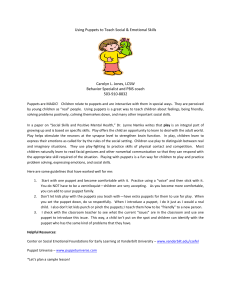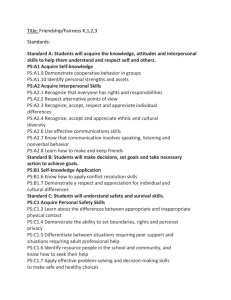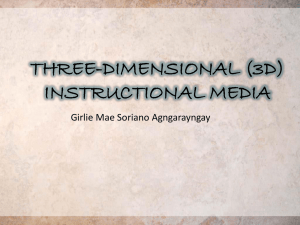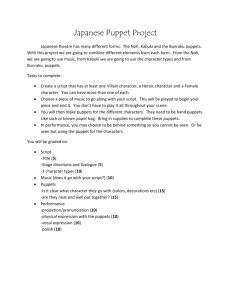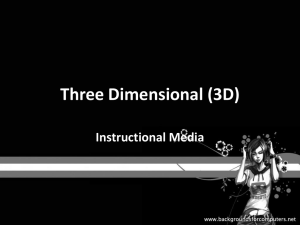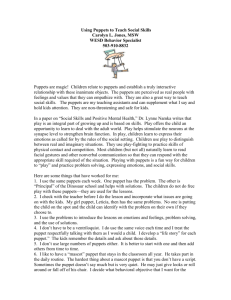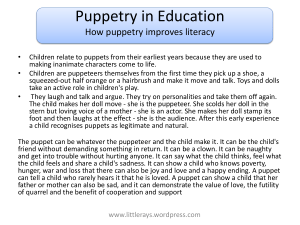Select, read and tell developmentally appropriate stories
advertisement
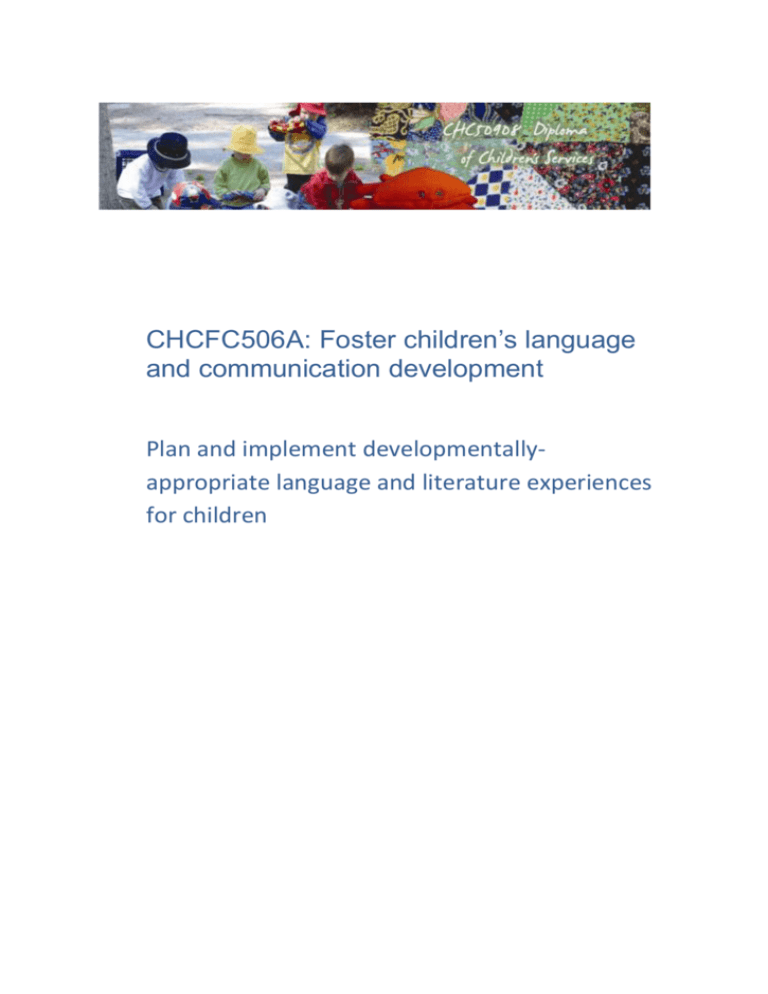
CHCFC506A: Foster children’s language and communication development Plan and implement developmentallyappropriate language and literature experiences for children Contents The importance of literature in our lives 3 Select, read and tell developmentally appropriate stories 4 Reading books to young children 4 Telling stories to young children 5 Use stories, rhymes and poetry to enhance children’s enjoyment of language When to use poetry and rhymes 8 Literacy activities 9 Include language and literature experiences that support acceptance and appreciation of diversity 12 Experiences that support diversity 12 Use puppets and other props to stimulate children’s enjoyment of language and literature 2 7 15 Puppet theatres 17 Feltboard stories 19 Paper stories 21 Diploma of Children’s Services: CHCFC506A: Reader LO 9319 © NSW DET 2010 The importance of literature in our lives As a childcare worker you need to be aware of the importance of literature in our lives and to have the enthusiasm and confidence to inspire children to use and enjoy books. Why is literature important? Why should we try to encourage children to read. Why should we as adults read? Here are some ideas to think about: • • • • • • • Literature provides pleasure and entertainment and relaxation. Literature provides us with information and education. Literature helps us to understand ourselves and our world. Literature widens our personal viewpoints. We can learn to see things from another person’s point of view and develop empathy. Literature offers us new ideas and new information which can fire our imagination and dreams. Literature helps us to interpret events. Our oral language is fed and enriched by literature. If literature is important, how can we encourage children to read? We, the adults in the children's lives, need to enjoy and use books and be seen by children to do so. We also need to read to children often, things which are at the right level for their enjoyment and understanding, and which we enjoy ourselves. Understanding how children acquire language and literacy is fundamental to providing appropriate language arts provisions and experiences. Language does not develop in isolation. Language development and other areas of development are very much intertwined. Language and literature experiences do not simply support the area of the communicating child (language development). They also greatly influence the child’s sense of self, the healthy, physically active child (physical development), the social child (social development), the feeling child (emotional development), the thinking child (cognitive development), the creative child (creative development) and the spiritual and moral child. Language is a multifaceted tool which allows us to express and deal with feelings and thoughts, to interact cooperatively with others, to understand and communicate ideas and to develop knowledge and skills. Diploma of Children’s Services: CHCFC502A: Reader LO 9319 © NSW DET 2010 3 Select, read and tell developmentally appropriate stories Reading books to young children ‘The more children hear stories read and told, the greater their understanding of the world of books and the uses of literacy.’ (Barratt-Pugh, C and Rohl M (2000) p 124) Reading to children Whithead (2004) suggests that reading books with children at an early age may have a large influence on children’s attitudes to books and literature and on their development as readers and writers in the future. Reading a book to children can seem a very simple experience. However, the way you read has a profound effect on the outcome for the child, both in terms of their enjoyment and their attitudes to reading and literature. When you read to children: • • • • 4 choose the story carefully, taking into account the children’s ages and interests before you read it to a child, read it through to yourself, getting the feel of the story line and the characters—you will be able to enjoy the experience more if you are familiar with the book position yourself so that everyone is comfortable, close to you and the child or small group of children can see the book say the title and the author’s name to introduce the book—this will help children develop a concept of print and introduces the idea that books have authors and illustrators Diploma of Children’s Services: CHCFC506A: Reader LO 9319 © NSW DET 2010 • • • • • • • use your face, eyes and voice to convey atmosphere, excitement or action as well as different characters read at a pace at which children can enjoy the words and the illustrations at the same time balance reading and pausing; you need to keep the flow of the story going so that children can follow the plot but you can pause briefly to answer a question or acknowledge a child’s response questioning—remember these skills and use them at the beginning, during the story if appropriate and at the ending. Ask open-ended questions such as ‘what’s happening here?’ and ‘why do you think the girl was happy?’ link the story to an event or a child’s interest—this may invite the child to feel part of the story and contribute to discussion encourage older children to think critically—‘what would you do if you were there?’ reread the stories over and over again if the child requests this. Telling stories to young children Telling stories to children is part of a very old tradition. Stories are a means of communication between people of all ages. Smyth (1996) suggests that myths, legends, folk tales, fairy tales, oral histories, anecdotes and family jokes and stories are all part of our oral heritage. Telling stories to children How many stories can you think of from your own childhood? Often we do not think of ourselves as storytellers but in fact when we recount a story of what happened to us today or tell a traditional story such as The Gingerbread Man, we are using the old skills of storytelling. Estes (1993) (cited in Smyth, 1996, p 1) talks about storytelling: There is no right or wrong way to tell a story. Perhaps you will forget the beginning, or the middle or the end … . Ask the little ones their happiest moments. Ask the teenagers the scariest time of their lives … .Give the old Diploma of Children’s Services: CHCFC502A: Reader LO 9319 © NSW DET 2010 5 ones the floor. Go all around in the circle ask each person. You will see everyone is warmed, sustained by the circle of stories you create together. Storytelling depends on the spoken word so that a story is created in the imagination. It is a creative and expressive activity which connects the teller and the listener. The storyteller’s voice, facial expressions, eye contact and personality become part of the story. The storyteller can respond to the children’s interest and responses by adapting the story. Storytelling allows the children to create their own images for the words you are using. Learning to tell stories • • • • • • • • Choose stories that you like and would like to share. Consider the ages, interests and ability to listen of the children. Choose stories which have a well-developed plot, that have repetition so that the children can join in and have predictable language, eg The Three Little Pigs. Choose stories that have conversation, eg ‘I’m coming to gobble you up’ in The Three Billy Goat’s Gruff. Read the story aloud. Think about the effect you want the story to have. Learn the first and last sentences of the story as well as any key repetitions. Practise telling the story to yourself and others. Ideas for selecting stories to tell • • • Tell stories about real things that have happened to the children, people they know or to yourself. Use traditional folk stories such as Goldilocks and the Three Bears, Little Red Riding Hood, Cinderella, or tales from your own culture. Use Aboriginal and Torres Strait Islander stories like The Rainbow Serpent. Activity 1 6 Diploma of Children’s Services: CHCFC506A: Reader LO 9319 © NSW DET 2010 Use stories, rhymes and poetry to enhance children’s enjoyment of language Nursery rhymes, action rhymes (fingerplays) and poetry are all important components of the language and literature area for young children and must be considered in a language-rich environment. Nursery rhymes are traditional rhyming verse or sayings considered to be suitable for young children. Action rhymes are things like fingerplays and tickle games. They are rhyming verses which are accompanied by finger, hand or body actions. Poems are compositions in which words and images are selected to create rhythms, rhymes, form and order. Can you recall any rhymes, action rhymes or poems from your youth? Think about why you recall these. Is it because they have rhythm, that they rhyme, are funny, are repetitious? Visit the following sites for many examples of songs, rhymes and poems that you can use with young children: http://preschoolrainbow.org/preschool-rhymes.htm http://www.indianchild.com/nursery%20rhymes.htm http://www.earlyliterature.ecsd.net/resources 1.htm http://www.sqedunk.com/Original-Finger-Play-Songs.htm http://www.nncc.org/Curriculum/fingerplay.html http://www-personal.engin.umich.edu/~ajdrake/toddler/fngr2.htm http://www.songsforteaching.com/nurseryrhymes.htm http://www.gigglepoetry.com/ Some of these sites have sound as well as the lyrics and actions to accompany them. Diploma of Children’s Services: CHCFC502A: Reader LO 9319 © NSW DET 2010 7 Activity 2 When we use rhymes and poetry with children they provide a wealth of opportunities to discover new words, ideas and attitudes towards language, literature and literacy. Machado (2003) suggests that when we use poetry with children we: • • • • • • • encourage listening skills encourage children to experience the pleasure of hearing sounds encourage enjoyment of language and humour stimulate children’s imagination increase vocabulary and knowledge of the world encourage an understanding of rhyme and rhythm familiarise and expose children to classic and contemporary poetry that is part of our heritage. Techniques for using poetry and rhymes • • • • • • • • • • • • Know the piece (poem or rhyme) well; practise reading it out loud. Read the poem in full, not line by line. Avoid using a ‘sing song’ voice. Use the rhythm of the piece. Recognise the punctuation used. Use voice, face and body expression. Use actions to encourage children’s participation. Emphasise words where appropriate. Adapt verses to meet children’s interests. Do not require children to memorise the poem or rhyme word for word. Include children’s names where appropriate. Create the children’s and your own poetry, rhymes and fingerplays. When to use poetry and rhymes Use poetry and rhymes: • • • • • • • 8 any time of the day as a one-to-one experience in small groups integrated with books, stories, pictures, puppets, feltboards and any other experiences as an introduction or on their own in both planned and spontaneous experiences at transition or routine times. Diploma of Children’s Services: CHCFC506A: Reader LO 9319 © NSW DET 2010 ‘Once upon a time there was an egg/man sitting on a wall who fell and broke into a million pieces. No-one could help him. The end.’ You would never read or tell this story to a child. Yet, as a nursery rhyme, ‘Humpty Dumpty’ has been a favourite for generations of children. Find the rhyme and repeat it over and over to experience the rhythm. To children, the silliness of rhymes does not matter. The rhythm and melody are the things that children enjoy. Nursery rhymes are organised so that similar sounds ‘jump out’ at you and are repeated. Nursery rhymes have a lot more to offer than entertainment. They introduce children to the idea of a narrative, promote social skills, promote language development and lay the foundations for literacy development. Visit: http://www.a-better-child.org/page/796741 children’s poetry websites which contains a list of Activity 3 Literacy activities This involves emerging reading and writing skills and encouraging the use of written language. Early literacy is the growing ability to construct meaning from print; it is the skills, knowledge and attitudes that come before and lead up to reading and writing. It includes learning: • • • to communicate and listen the sounds of spoken language about letters and the words they make and about the world around you. Reading and writing are based on the sounds of language. Children develop literacy through their involvement in everyday home and community experiences, including life in children’s services. Success in literacy comes from building on what children already know. Go to http://www.newcastle.edu.au and click on Research and do a search for Literacy. You should find Literacy as Social Practice. This explains what literacy is, everyday literacy experiences, what literacy is as social practice and how children learn literacy. Diploma of Children’s Services: CHCFC502A: Reader LO 9319 © NSW DET 2010 9 Carer with a collection of books Strategies to encourage emerging literacy skills • • • • • • • • • • • Point to words in books as you read. Make lists or recipes for experiences such as cooking. Point to signs in the environment when going for a walk. Make road and traffic signs or encourage children to make their own. Write letters in the sand or earth. Make positive comments about children’s attempts at writing. Model correct print script. It is recommended you use lower case, foundation-style script. Use capital letters only when appropriate. Go to this website for an example of foundation script: http://www.bosnswk6.nsw.edu.au/parents/k6writing.html Record children’s work and encourage children to record their own work and to dictate or write their own stories. Read children’s ‘pretend’ writing. Develop the writing learning centre in the environment. Display posters with words in the environment. Point to words and pictures as you read 10 Diploma of Children’s Services: CHCFC506A: Reader LO 9319 © NSW DET 2010 Encouraging the use of written language Children will gradually be able to form their own symbols and letters, then construct words and finally sentences. There is a view that when children are doing this they are making sense of things. They will write letters backwards and upside down. Visit the following sites and search for ‘emerging literacy’ for some interesting ideas: http://childrenandcomputers.com http://www.grammarandmore.com/tips/homework.htm http://ecr.sagepub.com/cgi/content/refs/2/1/51 Diploma of Children’s Services: CHCFC502A: Reader LO 9319 © NSW DET 2010 11 Include language and literature experiences that support acceptance and appreciation of diversity Experiences that support diversity Lowe (2000, p 2) states: ‘A supportive learning environment starts with a positive attitude towards diversity in all its forms. Activities should be designed to reflect the home backgrounds and interests of the children … The diverse range of language and literacy experiences children bring to the learning situation needs to be recognised, embraced and respected.’ Go to the NSW Curriculum Framework at: http://www.community.nsw.gov.au and read the section on pages 58 and 59 about the Communicating Child, ‘Communication and Diversity’, ‘Maintenance of the first language and English as a second language’. A fine example of supporting diversity and imagination 12 Diploma of Children’s Services: CHCFC506A: Reader LO 9319 © NSW DET 2010 Reflecting diversity, anti-bias and different cultural perspectives Families and the community are key participants in early childhood language learning. We need to be aware of home languages and accommodate children’s knowledge and experiences into the program. Invite families to participate in the centre’s program. Be careful not to make assumptions in regard to cultural issues—not all Asian people eat with chopsticks, not all Australians can swim. Do not lose sight of the individuality of children, their families and the community in which they live. Reflect on what you ‘know about the lives and experiences of the indigenous children – how do they spend their time? What do the families value?’ (Building Bridges, 2002, p 10) Appropriate language and literature resources and props Makin, Campbell and Jones Diaz (1995) suggest that programs should be culturally as well as linguistically relevant. Each child should find reflected in the people, the languages, the provisions and experiences and the meals elements which are familiar and elements which are new, so that the environment mirrors the diverse nature of the wider world. In language-rich environments, all children can explore other languages as well as their home language. When children are exposed to languages other than their own, they are provided with opportunities to develop positive attitudes towards the diverse ways in which people communicate. Books, pictures, displays and other materials provided for children should present images of: • • • • • family life, including different family structures, lifestyles and family members Aboriginal and Torres Strait Islanders and other cultural diversity differing cultures of children and families attending the centre and within the community contemporary lifestyles and celebrations community roles and services. Avoid stereotypical images, portrayals and tokenism. Children’s books should challenge early biased and prejudiced attitudes, avoid sexist and stereotypical roles and convey positive messages about difference. For example, single mothers and fathers, varying family structures, children with Diploma of Children’s Services: CHCFC502A: Reader LO 9319 © NSW DET 2010 13 diverse abilities, children and adults in wheelchairs and many other differences need to be presented to children through books. Singing songs and saying rhymes are experiences that help English language learners use their new language orally for the first time. Visit http://members.tripod.com/~ESL4Kids/songs.html for some good ideas. Visit http://www.adl.org/education/assessing.asp to see an informative article concentrating on multicultural books. The article suggests that selecting good multicultural children’s books involves an anti-bias approach and an active commitment to challenging prejudice, stereotyping and all forms of discrimination. The article also contains a comprehensive list of books. Activity 4 14 Diploma of Children’s Services: CHCFC506A: Reader LO 9319 © NSW DET 2010 Use puppets and other props to stimulate children’s enjoyment of language and literature Puppets have always been popular as a versatile and valuable language arts resource in early childhood settings, although they are often under-used. For a storyteller, they can be an important and effective tool in maintaining audience attention, involving listeners in the telling of the story and providing a visual experience to enhance the aural story. Almost any inanimate (non-living) object can become a puppet if you treat it as having some life and a personality. You can think of a puppet as an instrument for you to use to express ideas, to make suggestions, to entertain and to motivate. Puppets can represent people, animals, objects or ideas. The important thing is that they are brought to life by you. Puppets can mean a number of things to children: a companion, a mouthpiece or an outlet for behaviour that may normally be disapproved. There are many different types of puppets—hand or glove puppets, finger puppets, rod or stick puppets, sock puppets, pop-up puppets, junk puppets, ‘found’ puppets, shadow puppets and marionettes. Puppets can be bought commercially, made by you and/or the children or found by you and/or the children. Different types of puppets Hand or glove puppets Glove puppets can be made with real gloves. Glove puppets can also be made by using different textured fabrics and felt outlining the shape of the hand like a mitten. Glove puppet Diploma of Children’s Services: CHCFC502A: Reader LO 9319 © NSW DET 2010 15 Finger puppets Rod or stick puppets Finger puppets are simple to make and need only a small amount of materials. They can be made of a fabric like felt which fits over your fingers, or the inside of a cardboard cylinder (not toilet rolls), or the puppet can attach to your hand so that your fingers act as the legs of the puppet. Following are some examples, including patterns. These are puppets held up by sticks—paddlepop sticks are an easy idea. You can use children’s drawings or pictures (magazines or photographs) or any other imaginative ideas you have. Stick puppets Sock puppets You can use old (clean) or new socks and attach hair or look-alike fur and facial features. Shadow puppets These puppets are usually made from stiff cardboard, often with a stick or rod attached, and the shadow is cast on a screen. Set up a screen (a white sheet works well or a length of hessian) and place strong lighting behind the screen, shining onto the sheet or hessian (a powerful torch or a desk lamp works well). Shadow puppets are exciting for young children and add a sense of mystery to the performance. Remember the fun of making shadow shapes on the wall when you were young? Marionettes 16 A marionette is manipulated with strings attached to the jointed limbs of the puppet and are usually purchased ready-made. They are fascinating to watch but please note that it takes mature skills and practice to manipulate a marionette successfully. It is not recommended that you give these to young children. Diploma of Children’s Services: CHCFC506A: Reader LO 9319 © NSW DET 2010 Marionette Junk puppets Lots of junk material can be transformed into puppets by the children and yourself. Think of the possibilities of egg cartons, cardboard cylinders, boxes, foam chunks, pantyhose or stockings or anything recycled—you will probably be able to add to the list. Found puppets As the name suggests, ‘found puppets’ are ones that you find—you can call anything a puppet—the only limit is your imagination. Found puppets may not look like puppets in the conventional sense. Think of some of the objects in everyday life that could be animated by you and could serve a particular purpose. • Lost shoes could plead for their owner. • A spade could ask to be returned to the sandpit. • on. The bathroom tap could cry when left You will find that young children suspend their disbelief far more easily than adults and so are far more accepting of familiar objects being used in this way. Puppet theatres Puppet theatres are not always necessary for puppet play but you may find they will add a sense of drama. Puppet theatres can be made from an old television set with its workings removed, a large carton or box, a table on its side or a sheet or blanket over a broom suspended between two chairs. For some ideas for puppets children can make themselves, go to the following website: http://www.pbskids.org/zoom/do/index.html As stated earlier, puppets are a versatile and valuable language arts resource. Values and uses include: • gaining children’s attention and encouraging them to participate in language and literacy experiences Diploma of Children’s Services: CHCFC502A: Reader LO 9319 © NSW DET 2010 17 • • • • • • • use by children or with children to encourage communication skills, speech and self-expression. Children who are hesitant or reluctant speakers, especially in group situations, will often use a puppet to speak through and can become more confident. allowing children to experiment with social situations, as an emotional release or to relive experiences—to speak through their puppet contributing to the development of positive self-esteem by giving the opportunity to be ‘in charge’ stimulating and developing imagination and pretence, to encourage creativity. Children will often make up their own stories and rhymes. using as props and adding impact for storytelling, reading poems, reciting rhymes using for a particular purpose as an activity in itself with a puppet theatre developing manipulative skills through practice. Introducing and using puppets effectively We need to remember that some children may feel uncomfortable with or frightened by a puppet or puppets, so it would be wise to introduce a friendly, harmless-looking puppet to begin with. Children could be encouraged to see, feel, explore and use puppets before you begin the story. Puppet making by the children is another way to explore puppetry. Provide the materials and allow for creativity and imagination—remember the process is more important than the product. Children can also use puppets spontaneously during the day. You may find that they begin making their puppets sing, talk or dance before moving on to making or telling stories. Practical puppetry hints • • • • • • • 18 Choose a puppet that has character. When you are speaking, keep the puppet still unless you are expecting a response from the puppet. Use movements when the puppet is speaking. Allow the puppet to make and maintain eye contact with the children while you focus on the puppet. Ask children to listen to the puppets. Do not try to be a ventriloquist—children will accept that your lips will move and your hand or arm is inside the puppet. If you are presenting a story, try to involve the children as much as possible. Stories should contain action that can be shown through the movements and voices of puppet characters (facial expressions are not possible with puppets). Diploma of Children’s Services: CHCFC506A: Reader LO 9319 © NSW DET 2010 Many of the classic folk tales work well with puppets, but do not limit yourself to these. Visit: http://www.earlychildhood.com/Articles/index.cfm?FuseAction=Article&A=200& PrintVer This article, The Story is Just the Start has some good information about using puppets when telling stories. Feltboard stories In this section we will develop the idea of a told story using a feltboard as a prop, how to make a feltboard and how to use a feltboard story. Feltboards are a popular and useful storytelling tool and language arts prop. Feltboards are made from felt and the felt pieces ‘magically’ stick to the board. Feltboards can be used for many purposes. They can be used with individual children or a small group. They can be used to help tell a story, for children to retell a story or make their own stories, to promote discussion, to introduce concepts, to introduce a poem or a rhyme, to illustrate songs, to build on emerging interests or for children making their own pieces and their own stories. Feltboards provide an attractive focus of attention and help sustain interest by providing an element of surprise or continuing suspense as felt pieces are added to the board. Pieces can be used as a prompt to children as to the sequence of a story, song, fingerplay or poem. How to make a feltboard You will need: • • A notice board (cork works well) from a homeware store Felt—the best colours to use are dark: black, dark green, dark blue. They make good natural backgrounds for the felt pieces. Cut your felt slightly larger than the size of the board and glue it to the notice board on both sides, making sure it is perfectly smooth. Tuck any overlap under the frame. Feltboard pieces are meant to be aids to the story, not a complete set of illustrations. Provide only a few simple pieces that are essential to the story rather than pieces for every event so that your words and the children’s imaginations provide the images. Diploma of Children’s Services: CHCFC502A: Reader LO 9319 © NSW DET 2010 19 How to make feltboard pieces The pieces can be made from felt or paper with a sandpaper backing (be aware that paper may tear easily). Use your imagination or use pictures from books as templates (photocopy the pictures, then cut them out and use the shapes as patterns). Do not use cartoon-like characters—mice should look like mice, not like Mickey Mouse. Features can be drawn, glued or sewn onto the pieces. When making pieces, keep sizes in their correct proportions. For example do not make a dog and a horse the same size. Consider size in another way—very small pieces will be difficult for the children to see and very large pieces will fall off the board. Choosing stories for the feltboard Choose a story that requires only a few pieces. Choose a story in which your placement of the pieces is not crucial, otherwise you might spend too much time arranging the pieces and not enough time on the story. Maybe make the pieces double-sided so that you can turn them over to go in the opposite direction. An easy example is The Three Billy Goats Gruff. You would need three goats of differing sizes (little, middle sized and big), one troll, a bridge and grass on the other side. Feltboard animals Feltboard backgrounds Examples of ways of using a feltboard Use Examples Comments To tell stories: The Three Billy Goats Gruff Telling the story Traditional Contemporary The Rainbow Fish? Poems 20 Children can use the pieces to retell the story themselves You can use a character or item from the poem to introduce it or stimulate Diploma of Children’s Services: CHCFC506A: Reader LO 9319 © NSW DET 2010 discussion Songs Old MacDonald had a Farm You or the children could add the pieces as the song develops Nursery rhymes Hickory Dickory Dock Familiar characters that the children can use easily To illustrate concepts Life cycle of the frog Numbers Shapes Size Classifying Children’s own interests, drawings, stories From existing pieces Making their own Keep a container of simple pieces that do not belong to any particular story Children can make their own from paper glued onto sandpaper or felt Using a feltboard • • • • • • • • • Select the story, fingerplay or concept to be introduced. Decide on the pieces to best highlight the sequence of events of the story. Prepare the pieces and arrange in sequence. Rehearse before presenting to the children. Consider visibility for all who are to view the presentation. Set realistic limits, where applicable. Manipulate the pieces effectively. Pieces should enhance the story, not distract from the telling of it Store felt pieces flat ready for next use. Activity 5 Paper stories You can also tell a story using paper as a prop. This is done by the telling the story and either: • • • drawing parts of the story as you go cutting the paper as you tell the story or folding the paper as you tell. Diploma of Children’s Services: CHCFC502A: Reader LO 9319 © NSW DET 2010 21 Sometimes the children do not know what the end of the result is going to be that you are drawing, cutting or folding so it keeps their attention very well. Do an internet search for ‘paper told stories’ and look out for these authors: • • • • 22 Ruth Atkinson – also runs workshops in NSW on told stories Hiroko Fujita Jean Stangl Ann Pellowski Diploma of Children’s Services: CHCFC506A: Reader LO 9319 © NSW DET 2010
